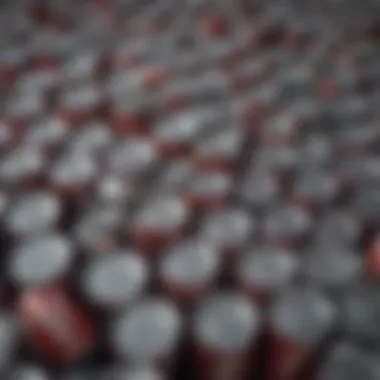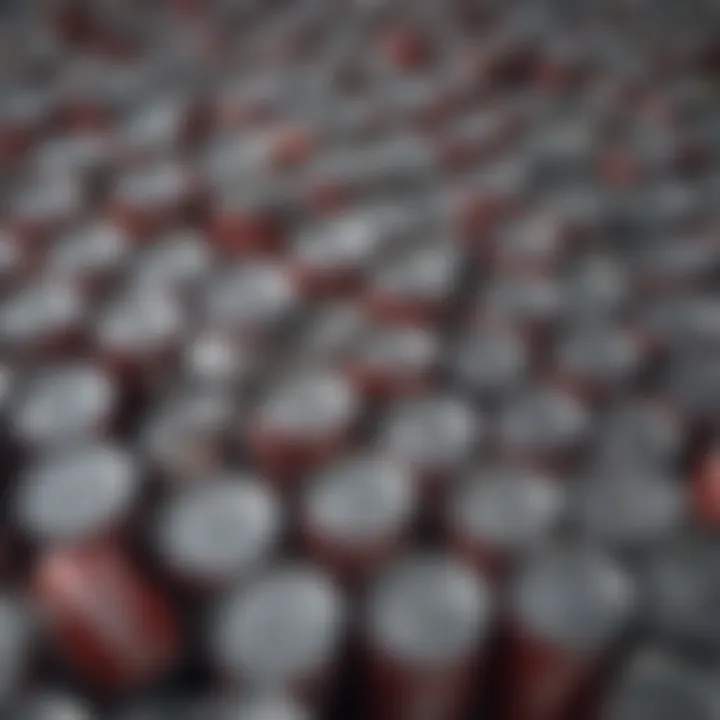Recycling Canned Food Cans: A Comprehensive Guide


Overview of the Topic
Recycling canned food cans represents a crucial aspect of waste management and environmental sustainability. Each year, millions of aluminum cans are produced and consumed worldwide. When discarded, if not recycled, these cans can contribute significantly to landfill waste. Therefore, understanding the processes involved in their recycling is paramount. This article aims to demystify the journey of canned food cans, their impact on the environment, and the benefits of recycling them.
Aluminum is a key natural resource. It is lightweight, durable, and recyclable. The recycling process for aluminum cans saves energy, conserves resources, and reduces greenhouse gas emissions. In today’s world, where environmental concerns are more pronounced, this topic becomes even more significant. Recycling aluminum not only supports conservation efforts but also represents a sustainable choice for both individual consumers and organizations.
Current Status and Challenges
Currently, the recycling rate of aluminum cans is relatively high compared to other materials. However, many challenges remain. Consumer behavior is one of the most significant factors affecting recycling rates. Despite awareness, not everyone practices recycling consistently. Issues include contamination of recyclables and insufficient infrastructure in certain areas.
Local policies also play a role in recycling effectiveness. Areas with robust recycling programs generally see higher recovery rates. In contrast, regions lacking policy support often struggle. This creates a disparity in aluminum can recycling across various communities.
Sustainable Solutions
Several sustainable practices can enhance the recycling of canned food cans. Education is vital. Informing the public about the benefits of recycling and how to do it correctly can have a noticeable impact. Furthermore, businesses can implement take-back programs or incentives for returned cans.
Promising examples of effective resource management can be found in cities with strong recycling initiatives. For instance, San Francisco has a comprehensive zero waste program aimed at reducing landfill waste significantly. Such successful case studies demonstrate that with the right practices, recycling rates can soar.
Impact and Importance
The impact of recycling aluminum cans extends beyond environmental benefits; it influences ecosystems, communities, and future generations. Recycling conserves natural resources and reduces pollution. Moreover, successful recycling programs can boost local economies by creating jobs in the recycling and manufacturing industries.
In essence, the importance of conservation efforts cannot be overstated. Sustainable resource use not only preserves the environment but also ensures that health and well-being are prioritized for future generations. Participating in recycling endeavors ultimately contributes to a greener planet.
"Every aluminum can recycled rather than landfilled conserves enough energy to run a television for three hours."
By embracing these practices, individuals and organizations can foster a culture of sustainability that benefits everyone.
Preamble to Aluminum Can Recycling
Aluminum can recycling is not just a waste management issue; it is a critical component of a sustainable future. Aluminum is widely used in various products, most notably in canned foods and beverages. With the increasing awareness of environmental conservation, understanding how to recycle these materials efficiently has become paramount. Recycling aluminum cans significantly reduces the amount of energy consumed compared to producing new cans from raw ore. Furthermore, it conserves natural resources such as bauxite, the primary mineral used in aluminum production. Ultimately, recycling practices help to mitigate the effects of climate change by lowering greenhouse gas emissions.
Overview of Aluminum Usage
Aluminum is a versatile metal found in an array of products, from construction materials to aerospace components. However, its most prevalent use remains in food and beverage cans. The lightweight nature of aluminum, combined with its resistance to corrosion, makes it ideal for packaging. Approximately 75% of aluminum ever produced is still in use today due to its recyclability. This high recycling rate is a testament to the material's longevity and importance in sustainable practices. Additionally, aluminum cans are 100% recyclable without any loss in quality, allowing for an infinite recycling loop.
History of Can Recycling
The history of aluminum can recycling is relatively brief but significant. The modern aluminum can was first introduced in 1959, and recycling campaigns began in the early 1970s. Initially, the recycling of aluminum cans was not widely practiced, but as public consciousness around environmental issues grew, so did the recycling efforts. The presence of more recycling bins and established collection methods made it easier to return cans. By the 1990s, aluminum can recycling rates had increased dramatically, owing to both governmental initiatives and public awareness campaigns. Today, recycling programs are well-established across most regions, ensuring that used cans are appropriately collected, processed, and transformed back into new products.
The Recycling Process Explained
Understanding the recycling process is vital not only for the sustainability of our environment but also for the economic benefits it can bring. Recycling canned food cans involves several specific steps, each playing a crucial role in ensuring that these materials are properly processed and reused. This section will provide clarity on how aluminum cans make their journey from disposal to the recycling plant, and ultimately back into the marketplace, highlighting the key benefits and considerations surrounding the recycling of this ubiquitous material.
Collection of Canned Food Cans
The first step in the recycling process begins with the collection of canned food cans. This stage is fundamental; it determines the volume and quality of cans that can be recycled. Collection usually occurs through curbside recycling programs or designated drop-off centers.
- Curbside pickup: Many local governments offer curbside recycling services. Households place their recyclables, including aluminum cans, in designated bins for collection.
- Drop-off centers: These are locations where consumers can take their recyclables directly. Often, people who are more environmentally conscious may choose this route to ensure their cans are getting properly sorted.
Effective communication about collection schedules and procedures can increase participation rates, ensuring more cans are recycled rather than thrown away.
Sorting and Cleaning
After collection, the next vital phase is sorting and cleaning. At recycling facilities, the collected cans are mixed with other recyclables. Mechanized sorting systems are employed to separate aluminum cans from other materials. Workers or automated systems remove contaminants, such as plastic or glass. This process is essential; contamination can lead to less favorable recycling outcomes and devaluation of the material.
- Magnetic separation: Steel cans are removed using magnets, as aluminum is not magnetic.
- Visual inspection: Workers inspect the sorted materials to catch any remaining contaminants.
Once sorted, the aluminum cans are cleaned to remove any residual food or liquids. Proper cleaning is crucial, as dirty cans can compromise the quality of the recycled aluminum.
Melting and Repurposing
The final step in the recycling process is melting and repurposing. Cleaned aluminum cans are fed into a furnace, where they are heated to melt down to molten aluminum. This part of the process is energy-intensive but results in a base material that can be molded into new products.
- Energy efficiency: Notably, recycling aluminum consumes around 95% less energy than producing new aluminum from raw materials.
- Quality of recycled aluminum: The melting process does not degrade the quality of aluminum, allowing for continuous recycling without loss of material properties.
Once melted, the aluminum is cast into large blocks, known as ingots, which can then be transported to manufacturers. These ingots serve as raw materials for making new cans and other aluminum products, completing a closed loop.
"Recycling aluminum saves energy and conserves natural resources, making it an essential practice for sustainability."
Environmental Benefits of Recycling


Recycling canned food cans offers a variety of environmental advantages, making it a crucial topic in the discussion of sustainability. The process significantly minimizes waste, preserves natural resources, and reduces greenhouse gas emissions. Together, these elements contribute to a healthier planet. Let’s explore these benefits in more detail.
Reduction of Landfill Waste
One of the most immediate benefits of recycling aluminum cans is the reduction of landfill waste. Canned food cans take a long time to decompose if disposed of in landfills. When recycled, aluminum can be reused indefinitely without degrading its quality. According to the Aluminum Association, recycling one ton of aluminum conserves about 9 tons of bauxite, which is the primary ore from which aluminum is extracted. This conservation not only reduces the volume of waste in landfills but also saves space and resources that would be otherwise used in landfill management.
Conservation of Natural Resources
Recycling cans also plays a vital role in conserving natural resources. The extraction and processing of raw materials required for aluminum production are energy-intensive and damaging to the environment. Extracting bauxite, for instance, often involves mining processes that disrupt ecosystems and wildlife habitats. By recycling aluminum cans, we diminish the demand for new aluminum, thereby alleviating pressure on natural resources. This efficient use of existing materials helps sustain the environment for future generations.
Lowered Carbon Footprint
The environmental impacts of recycling extend to its contribution to a lowered carbon footprint. Melting recycled aluminum requires about 95% less energy compared to producing new aluminum from raw ore. This energy conservation not only reduces operational costs but also cuts down on greenhouse gas emissions associated with the production process. By minimizing energy use, recycling contributes significantly to reducing global warming potential. In essence, each can that is recycled is a step toward combating climate change and promoting a sustainable future.
"Recycling aluminum cans can save enough energy to power a home for nearly one month!"
In summary, the environmental benefits of recycling canned food cans cannot be overstated. By reducing landfill waste, conserving natural resources, and lowering carbon emissions, we can navigate towards a more sustainable future. As consumers, understanding and participating in these processes is crucial for the collective effort to preserve our environment.
Recycling Rates and Statistics
Recycling rates and statistics serve as critical indicators of how effectively a society manages its waste, particularly concerning aluminum can recycling. Understanding the nuances of these rates is not only essential for assessing environmental impact but also for recognizing trends that can help shape future policies and behaviors. Successful recycling results in reduced landfill use, conservation of resources, and enhanced economic return. Hence, having a clear picture of current rates and historical data assists stakeholders in making informed decisions about improvement areas.
Current Recycling Trends
The landscape of recycling is continuously evolving. Recent data indicate a growing awareness and engagement in recycling practices among the public and organizations alike. According to the Aluminum Association, the recycling rate for aluminum cans reached approximately 73% in recent years, illustrating a significant increase compared to previous decades. This trend is attributed to various factors, including educational campaigns, increased accessibility of recycling programs, and value placed on sustainability.
Additionally, many regions have adopted advanced technologies that streamline the recycling process, thereby enhancing efficiency and reducing costs. Such advancements have made recycling more appealing to both businesses and consumers. Popular initiatives, like the "bottle deposit programs," motivate individuals to return their cans for a financial reward, reflecting how economic incentives can positively influence recycling participation rates.
Regional Differences in Recycling Rates
Recycling rates can vary dramatically across different regions, influenced by multiple factors such as local policies, community engagement, and economic conditions. For instance, states like California have made notable strides in increasing aluminum can recycling rates due to stringent environmental regulations and successful public awareness campaigns. In contrast, other regions with less robust recycling legislation struggle to reach acceptable levels of recovery for aluminum cans.
Access to recycling facilities also plays a crucial role. Urban areas often have more resources and facilities than rural counterparts, thus impacting local recycling rates. Socioeconomic status can also influence participation—higher income levels typically correlate with better recycling practices. This disparity highlights the need for tailored strategies that address the unique needs of each community.
Factors Influencing Recycling Success
Numerous elements affect the overall success of aluminum can recycling programs. Public awareness is paramount. Communities that prioritize educational outreach often see higher participation rates. Workshops, school programs, and social media campaigns can effectively highlight the importance of recycling and its benefits for the environment.
Economic incentives also significantly impact recycling behaviors. Initiatives that offer financial returns for recycling, as mentioned previously, encourage individuals to participate. Furthermore, clarity in recycling guidelines plays a vital role. Many people want to recycle; however, confusion over what materials are accepted can lead to contamination and reduced recycling rates.
Finally, corporate responsibility is crucial. Businesses can lead by example, implementing robust recycling programs and encouraging employees and customers to participate actively. Collaboration between local governments, businesses, and citizens creates an ecosystem of support that enhances recycling success.
Effective recycling stems from a collective effort that engages various community stakeholders.
Challenges in Recycling Canned Food Cans
Recycling canned food cans presents several challenges that need addressing to enhance efficiency and effectiveness. Understanding these challenges is essential for consumers, policymakers, and organizations engaged in recycling efforts. Each challenge contributes to the overall success rate of recycling programs, impacting environmental outcomes and economic viability.
Contamination Issues
One of the most significant obstacles in aluminum can recycling is contamination. Cans that are not adequately cleaned before being placed in recycling bins can lead to a variety of problems. Residual food waste, grease, and liquids can contaminate the recycling stream, lowering the quality of recycled materials. This can result in more resources being needed to process aluminum and, in some cases, may lead to entire batches being deemed unsalvageable.
To mitigate contamination, proper consumer behavior is critical. Rinsing cans before recycling is a straightforward practice, yet often overlooked. Establishing community education programs that emphasize the importance of cleaning cans can significantly enhance the recycling process.
Economic Viability of Recycling Programs
The financial aspect of recycling programs also presents challenges. While recycling aluminum saves energy and reduces pollution, the initial costs of establishing and maintaining efficient recycling systems can be high. Local governments and organizations must balance budgets, leading to decisions that may not favor robust recycling programs if immediate financial returns are not visible.
Moreover, market fluctuations can affect the value of recycled aluminum. A drop in demand for recycled materials can discourage investment in recycling infrastructure. Addressing the economic sustainability of these programs is essential to ensure that they continue to operate effectively, and finding ways to make recycling programs financially attractive without sacrificing quality is a pressing need.
Public Awareness and Participation
A third significant challenge lies in public awareness and participation regarding recycling practices. Many consumers remain unaware of the specific guidelines related to recycling aluminum cans or may not recognize the tangible benefits of their efforts. Without increased awareness, participation rates tend to decline, which diminishes the overall efficacy of recycling programs.
Education plays a vital role here. Informative campaigns can help convey the importance of recycling and instill a sense of responsibility among citizens. Encouraging community involvement, such as organizing local recycling events or providing incentives for participation, can also foster a culture of recycling. Studies show that communities with active outreach and engagement often report higher recycling rates.
"Effective recycling relies heavily on informed consumers and their active participation in recycling programs."
Best Practices for Consumers
As awareness around environmental concerns continues to grow, understanding the role consumers play in recycling aluminum canned food is essential. Best practices for individuals can markedly enhance the effectiveness of recycling programs. By carefully preparing cans for recycling and adhering to local recycling guidelines, individuals contribute significantly to the reduction of waste and preservation of resources.
How to Prepare Cans for Recycling


Preparation of cans for recycling is a straightforward yet crucial step. The following guidelines ensure that aluminum cans are ready for the recycling process:
- Rinse the Cans: It is important to remove any food residue. Rinsing prevents contamination during the recycling process, which can hinder the effectiveness of recycling efforts. A quick rinse with water is usually sufficient.
- Remove Labels: While many recycling facilities can process labels, removing them can aid in more efficient recycling. If the labels are non-paper and do not wash off easily, it may be acceptable to leave them on.
- Flatten the Cans: Flattening cans saves space both in your recycling bin and during transport to recycling centers. Most recycling programs accept flattened cans, but checking local guidelines is advisable.
- Separate from Other Materials: Keep aluminum cans separate from other recyclables such as glass or plastics. This separation helps streamline the sorting process once the cans reach the recycling facility.
By following these preparation steps, consumers optimize the quality of aluminum recycled.
Understanding Local Recycling Guidelines
Each community has its own set of recycling guidelines. These can vary significantly depending on factors such as local capabilities and policies. Understanding these guidelines is vital for effective recycling. Here are key points to consider:
- Check Local Authority Resources: Many municipalities provide detailed instructions online. These may include which materials are accepted and specific preparation procedures.
- Participate in Local Programs: Joining community recycling initiatives can boost your impact. Many areas organize events focused on recycling education, informing residents of best practices.
- Stay Updated: Recycling regulations can change. Regularly consult your local recycling authority to ensure your knowledge is current.
"Understanding and following local recycling guidelines is not just about compliance; it is a commitment to sustainability that plays a significant part in the collective efforts to preserve our environment."
By being informed and active, consumers can make a direct and positive impact on recycling efforts.
The involvement of consumers in these practices forms a critical foundation for successful recycling initiatives. Emphasizing caution and diligence in the recycling process can lead to greater efficiency and efficacy in resource conservation.
The Role of Local Governments
Local governments play a crucial role in the recycling of canned food cans. Their influence is seen in various areas, such as implementation of policies, funding, and the overall encouragement of community participation. By establishing frameworks around recycling initiatives, local governments can facilitate a more sustainable environment. These organizations are often the first point of contact for citizens looking to recycle, and therefore, their effectiveness can set the tone for a community’s overall recycling behavior.
Policies Encouraging Recycling
Municipal policies are fundamental in promoting recycling practices among residents. Local governments can create regulatory frameworks that require curbside recycling services. This makes it easier for individuals to participate without having to seek out recycling centers on their own. Additionally, governments can implement incentives that encourage recycling of aluminum cans.
For instance, cities may introduce deposit return schemes. Such schemes provide a monetary reward for returning aluminum cans, which significantly boosts recycling rates. By placing value on the cans, communities are inspired to collect and return them. Overall, effective policies can drive change and transform the public view on waste and recycling.
Funding for Recycling Programs
Funding is another important aspect of local governments in recycling efforts. Governments can allocate budgets specifically for recycling programs. This enables the development of necessary infrastructure, such as collection points and processing facilities. Without proper funding, many recycling initiatives may struggle to survive.
Moreover, financial support can come in various forms. Local governments can apply for state and federal grants dedicated to enhancing recycling programs. They can also encourage partnerships with businesses and nonprofits aimed at sustainability. This collaborative approach ensures resources are efficiently utilized and more educational campaigns can be funded for public awareness.
Economic Aspects of Recycling
Recycling aluminum cans has considerable economic implications that extend beyond environmental benefits. Understanding the financial dynamics involves examining both the market factors driving demand for recycled materials and assessing the cost-effectiveness of recycling programs. The intersection of these two aspects defines the viability of can recycling initiatives and their potential contribution to the economy.
Market Demand for Recycled Aluminum
The demand for recycled aluminum is influenced by several factors. It is often less expensive to produce aluminum from recycled materials than from raw bauxite. This is because recycling aluminum saves approximately 95% of the energy required to create new aluminum from ore. Hence, industries show strong preferences for using recycled aluminum due to cost efficiency.
Additionally, industries, including automotive and packaging, increasingly commit to sustainability targets. Many companies actively source recycled materials to meet these goals, enhancing the market for recycled aluminum. The volatile nature of the global aluminum market also affects demand, with sharp rises in raw material prices making recycled aluminum a favorable option.
In recent years, some studies indicate that recycling rates directly correlate with market dynamics. As demand increases, so does the incentive for consumers and local authorities to improve recycling efforts.
Cost-Benefit Analysis of Recycling Programs
An effective cost-benefit analysis of recycling programs must consider both direct and indirect expenses and savings. Initial setup costs for recycling facilities can be significant. However, these costs may be mitigated by both local and federal government incentives that promote recycling initiatives.
Cost considerations include:
- Operational costs: The day-to-day expenses involved in running recycling programs, such as labor and transportation.
- Infrastructure development: Investment in recycling centers or automated systems may require substantial funding.
On the flip side, the benefits to consider include:
- Revenue generation: By selling recycled aluminum, facilities can generate significant income. This is compounded by the increasing market demand for recycled materials.
- Environmental savings: Although hard to quantify, reductions in landfill costs and environmental cleanup lead to long-term financial advantages.
"The long-term benefits often outweigh the initial costs, portraying recycling not just as an environmental duty, but also a financially sound decision."
Innovative Recycling Technologies
Innovative recycling technologies play a crucial role in enhancing the efficiency and effectiveness of recycling canned food cans. These advancements not only optimize the recycling process but also minimize waste and reduce the overall environmental impact. As the demand for sustainability grows, the implementation of new technologies becomes increasingly pertinent in solving existing issues within the recycling sector. This section explores two significant areas of innovation: advancements in melting processes and automated sorting systems.
Advancements in Melting Processes
The melting process is a critical stage in aluminum can recycling. Traditional methods often require substantial energy, leading to higher costs and greater environmental effects. Recent advancements have focused on improving energy efficiency during melting. Innovative techniques, such as induction melting and the use of alternative energy sources like solar power, are gaining traction. These methods help lower greenhouse gas emissions while also reducing operational costs.
Through precise temperature control and optimized furnace systems, the quality of the recycled aluminum is significantly improved. This consistent quality often leads to a higher market value for the recycled material. Besides, newer technologies are able to handle contaminated aluminum more effectively, reducing the need for extensive pre-processing. In this way, the entire recycling process becomes more efficient, contributing to a greater amount of aluminum being successfully reclaimed and repurposed.
Automated Sorting Systems
Automated sorting systems represent another important technological leap in the recycling of canned food cans. Efficient sorting is essential to ensure high-quality recycled materials. Modern systems use a combination of mechanical and sensor-based technologies to identify aluminum cans accurately and separate them from other materials. These systems can significantly increase sorting speed while also improving accuracy compared to manual sorting.


One notable technology involves the use of near-infrared spectroscopy, which allows for rapid identification of materials based on their unique properties. With improved sorting capabilities, recycling facilities can reduce contamination rates in the recycled stream. This leads to higher quality recycled aluminum, which meets industry standards more reliably. Consequently, this increases the economic viability of recycling programs aimed at aluminum can collection.
The End
Innovative recycling technologies, particularly advancements in melting processes and automated sorting systems, are enhancing aluminum can recycling. These technologies not only improve process efficiencies but also contribute to a more sustainable and economically viable recycling framework. As the industry continues to evolve, the integration of such technologies will play a vital role in optimizing the recycling ecosystem and ensuring long-term environmental benefits.
"The future of recycling lies in the embrace of innovative technologies that address both economic and environmental challenges."
By investing in these advancements, communities and organizations can significantly bolster their recycling efforts, ultimately achieving higher rates of material recovery and contributing to global sustainability goals.
Case Studies: Successful Recycling Programs
Recycling programs show the diversity of methods used to mitigate aluminum waste. Their importance is multi-faceted. They serve as real-world examples of how communities and corporations can successfully implement recycling initiatives. Understanding these case studies provides valuable insights into the strategies that yield positive outcomes, displaying the tangible benefits of sustained recycling efforts. Studies draw attention to what has worked in the past and how these methods can be leveraged for future initiatives while also evaluating the challenges that were faced alongside them.
Community Initiatives
Across various regions, community initiatives have emerged as a powerful force for recycling canned food cans. Programs are often localized, encouraging participation through clear messaging and accessible resources. One noteworthy example is the Keep America Beautiful program. This initiative mobilizes volunteers for clean-up events, raising awareness on the significance of recycling.
Benefits of such grassroots efforts include:
- Enhanced community engagement: Local pride motivates individuals to participate.
- Educational outreach: Programs often include workshops educating residents on recycling practices.
- Increased recycling rates: Visibility of community efforts often leads higher recycling participation.
Some communities have introduced incentive-based programs. Residents are rewarded for recycling through discounts at local businesses or points that can be redeemed for community events. This not only improves the recycling rates but strengthens community bonds.
Corporate Responsibility in Recycling
Corporate responsibility in recycling speaks to the broader role businesses play in environmental stewardship. Companies like Coca-Cola and Anheuser-Busch have implemented comprehensive recycling strategies. Their commitments focus not only on reducing their aluminum usage but also on improving the recycling infrastructure.
Factors contributing to successful corporate recycling efforts include:
- Investment in recycling technologies: By funding advanced recycling processes, companies improve efficiency.
- Collaborative partnerships: Corporations often work of public agencies and non-profits to expand their reach.
- Transparency in reporting: Firms that openly share their recycling statistics tend to build trust and encourage consumer participation.
The connection between corporate practices and community engagement is vital. Businesses that actively engage with their local environments inspire consumers to be more conscientious about recycling.
Spotlighting successful case studies provides a framework for others to replicate these models of success in both community and corporate contexts. As these programs evolve, their stories will guide future efforts in enhancing recycling initiatives at various levels, ultimately contributing to a more sustainable future.
Global Perspectives on Recycling
Understanding global perspectives on recycling is crucial. It offers insights into how diverse cultures approach waste management and recycling. The practices vary widely, reflecting local economies, environmental concerns, and regulatory frameworks. As such, recycling affects economies and ecosystems differently around the world. Recognizing these perspectives can enhance collaborative efforts in promoting environmental sustainability.
International Standards and Practices
International standards play a vital role in shaping recycling efforts. Organizations like the International Organization for Standardization (ISO) set guidelines that many countries adopt. These guidelines foster consistency in recycling practices across borders.
Some notable standards include:
- ISO 14001: Focuses on effective environmental management systems.
- ISO 18601: Concerns packaging and the concepts of recyclability.
Countries implementing these standards typically see improved recycling rates. The adoption of international best practices leads to efficient waste management and promotes sustainability. However, challenges remain. Different regions have varied capacities for recycling, thus resulting in inconsistencies.
Comparative Analysis of Global Recycling Rates
When analyzing global recycling rates, it becomes evident that geographical and economic factors influence these figures. For instance, nations like Germany currently lead in recycling, reaching rates close to 65%. Meanwhile, other countries lag, with rates under 20%.
Some influencing factors are:
- Government Policies: Countries with strong regulations and incentives achieve better results.
- Public Awareness: Education plays a crucial role. Where public engagement is high, so are recycling rates.
- Infrastructure: Accessibility to recycling facilities can significantly impact participation.
According to the Global Recycling Foundation, increasing awareness and accessibility could raise global recycling rates significantly.
Future of Canned Food Can Recycling
The future of canned food can recycling is crucial to many aspects of sustainability, economy, and innovation. As the conversation around environmental stewardship continues to grow, the recycling of aluminum cans becomes a focal point. This is not just about reusing materials; it touches on broader themes like waste management, energy consumption, and community engagement. Understanding emerging trends, along with the necessary collaborations, shapes how effectively this practice can evolve.
Emerging Trends and Innovations
Emerging trends in aluminum can recycling show promising directions that can lead to increased efficiency and greater acceptance by the public. Technologies that focus on the full lifecycle of aluminum— from production to disposal—are gaining traction. Innovations such as advanced sorting systems utilize artificial intelligence. These systems can significantly improve the accuracy of separating aluminum from other materials. The use of automation means quicker processing times, reducing operational costs for recycling facilities.
Also, companies are now exploring the potential of closed-loop recycling, where cans are made from recycled materials that can, in turn, be recycled again into new cans. This not only conserves resources but also dramatically decreases the energy required in the manufacturing phases. Consumers are also becoming more aware of the importance of recycling. Campaigns aimed at education are designed to deepen understanding about how to recycle effectively, influencing habits positively toward better recycling practices.
"We can change our future by rethinking how we handle waste, especially materials like aluminum. The potential is enormous if we adopt practices that marry innovation with responsibility."
Government and Industry Collaborations
The role of government and industry collaborations cannot be understated in the context of canned food can recycling. These partnerships create a robust framework for addressing challenges and pushing sustainable initiatives forward. Governments can provide essential funding and policy support that incentivizes recycling efforts. For instance, tax incentives for companies that utilize recycled materials can encourage greater participation and investment.
On the other hand, industries can bring resources and expertise that enhance recycling programs. By developing advanced recycling technologies and monitoring systems, businesses help achieve more streamlined collection processes. Together, these collaborations can lead to greater public awareness and the promotion of effective recycling behaviours. It encourages not only participation from consumers but also a long-term commitment to sustainable practices.
The cooperation between these entities can create a more circular economy, helping aluminum can recycling become a standard rather than an exception. This unified approach can help ensure that recycling practices are not just reactive but proactive, meaning they continue adapting to current trends and challenges.



